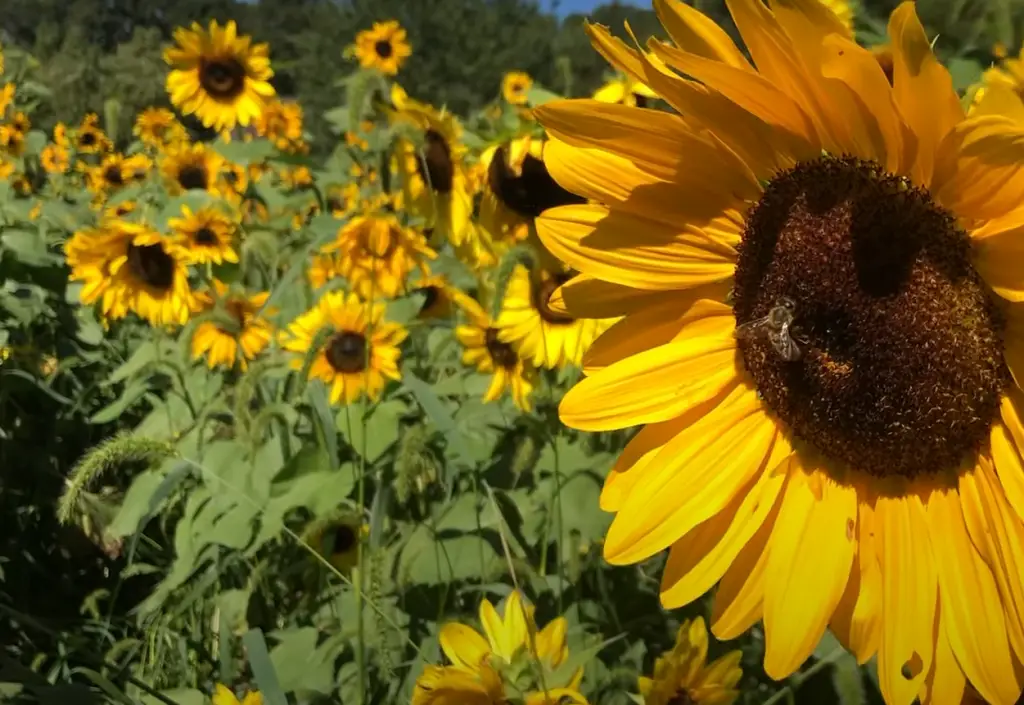Sunflower leaves turning brown is a common problem for gardeners everywhere. Sunflowers are notoriously sensitive to environmental conditions, and their leaves can start to turn brown if the plant is not properly cared for. Thankfully, it’s possible to prevent or reverse this discoloration with some simple tips and tricks. In this article, we’ll discuss what causes sunflower leaves to turn brown and provide useful tips on how to fix the problem.
Things To Know About Looking After Sunflowers
Sunflowers require a little extra care and attention to keep them happy and healthy. Here are some of the key things to remember when caring for your sunflower plant:
- Water regularly: Sunflowers need plenty of water, especially during their flowering season. Make sure you’re giving your plants at least one inch of water per week.
- Fertilize your plants: Sunflowers need nutrients, so be sure to use a fertilizer specifically formulated for flowering plants.
- Keep an eye on your sunflower’s leaves: If your sunflower’s leaves start turning brown, it could be a sign that something is wrong with the plant. Monitor your sunflower’s leaves closely and take action if you start to notice discoloration.[1]
Reasons Why My Sunflower Leaves Are Turning Brown & Dying
Leaf Disease
One of the most common causes of sunflower leaves turning brown is a fungal disease called downy mildew. This disease affects both young and old leaves, causing them to become discolored and eventually die.

To prevent this issue from occurring, make sure to avoid wetting your plant’s foliage when you water it. Additionally, applying neem oil to the foliage can help prevent and treat downy mildew.[2]
Rust Disease
Another fungal disease that can cause sunflower leaves to turn brown is rust. This disease affects both young and mature leaves, causing yellow spots on the foliage. To prevent this issue from occurring, be sure to keep your sunflowers away from damp areas and make sure they have proper air circulation. If you spot any yellow spots on the foliage, apply a fungicide to the affected area.
Beetle Damage
Another common issue that can cause sunflower leaves to turn brown is beetle damage. Beetles feed on the foliage of the plant, causing it to become discolored and eventually die. To prevent this problem from occurring, be sure to regularly inspect your plants for any signs of beetles or larvae. If you spot them, use an insecticide to rid your plant of the pests.
Fungal Wilting
Fungal wilting is also known as Fusarium Wilt, and it’s a fungal infection that can cause sunflower leaves to turn brown. This disease affects the stems of the plant and causes them to become weakened, eventually leading to drooping or discolored leaves.
Additionally, applying a fungicide to the plant can help prevent or treat this issue.[2]Glassy-winged Sharpshooter Damage
The glassy-winged sharpshooter is an insect that feeds on the foliage of sunflower plants, causing them to become discolored and eventually die. To prevent this issue from occurring, make sure to inspect your plants regularly for any signs of these pests. If you spot them, use an insecticide specifically designed to kill these insects.
Excessive Heat
Finally, the sunflower’s sensitivity to extreme temperatures can cause their leaves to turn brown and die. If your area is experiencing unusually hot weather, make sure you’re providing your plants with plenty of shade. Additionally, be sure to water them more often during periods of excessive heat.
Downy Mildew
Downy mildew is a fungal disease that can cause sunflower leaves to turn brown and die. This disease affects both old and young leaves, causing them to become discolored and eventually die.

To prevent this issue from occurring, make sure to avoid wetting your plant’s foliage when you water it. Additionally, applying neem oil to the foliage can help prevent and treat downy mildew.
Common Sunflower Leaf Problems
Dropping Leaves
Dropping leaves is a common issue with sunflower plants. This is usually caused by water stress, which occurs when the plant does not receive enough water. To prevent this from occurring, make sure your sunflower is getting at least one inch of water per week and that it’s planted in well-draining soil.
White Leaves
White leaves are a common issue with sunflower plants. This is usually caused by an iron deficiency, which can be fixed by applying an iron-rich fertilizer to the soil. Additionally, make sure the plant is getting enough light and water to prevent this problem from occurring.[1]
Yellowing Leaves
Yellowing leaves are a common issue with sunflower plants. This is usually caused by an iron or nitrogen deficiency, which can be fixed by applying a fertilizer rich in these nutrients to the soil. Additionally, make sure the plant is getting enough light and water to prevent this problem from occurring.[1]
Eaten Sunflower Leaves
Eaten sunflower leaves are a common issue with sunflowers. This is usually caused by insects such as aphids, whiteflies, or grasshoppers. To prevent these pests from attacking your plants, make sure to inspect them regularly and use an insecticide specifically designed to kill these bugs if you spot any of them on the foliage.
How To Stop Sunflower Leaves Turning Brown?
Seed selection
When selecting seeds for your sunflower, it’s important to choose varieties that are resistant to common leaf diseases. Look for varieties that have been bred specifically to protect against downy mildew and rust issues.
Mulch
Adding a layer of mulch around your sunflower can help protect the soil and prevent water stress.
Fertilizer
Using a fertilizer specifically formulated for flowering plants can help ensure that your sunflower has all the nutrients it needs to stay healthy and strong.

Additionally, make sure to avoid over-fertilizing your plants as this can cause them to become stressed out and susceptible to disease.
Pruning
Regularly pruning your sunflowers can help keep them healthy and encourage new growth. Make sure to remove any dead or discolored leaves to prevent the spread of disease. Additionally, be sure to prune back any stems that have become too long as this can cause them to lose their stability.
Irrigation
Making sure your sunflower receives the right amount of water is essential for preventing leaves from turning brown. Make sure to check the soil regularly and water your plants when needed. Additionally, avoid over-watering as this can cause root rot and other issues.[2]
How To Prevent Sunflower Leaves From Turning Brown?
Choose Nutrient-Rich And High-Quality Soil
Choosing a nutrient-rich and high-quality soil can help ensure that your sunflower will get all the nutrients it needs to stay healthy. Make sure to use a soil specifically designed for flowering plants and avoid areas with poor drainage.[1]
Do Not Overwater Or Underwater
As mentioned earlier, it’s important to avoid over-watering or under-watering your sunflower. Make sure you check the soil regularly and adjust your watering habits accordingly.
Proper Fertilization
Using a fertilizer specifically designed for flowering plants can help ensure that your sunflower has all the nutrients it needs to stay healthy. Additionally, make sure to avoid over-fertilizing as this can cause the leaves to become discolored and weaken the plant.
Protect The Leaves From Pests And Large Animals
Pests and large animals can cause damage to your sunflower’s leaves, leading to discoloration. To prevent this issue from occurring, make sure to inspect your plants regularly for signs of any pests or animals. If you spot any, use an insecticide specifically designed to kill them. Additionally, consider using a mesh fence around the plants to keep larger animals away.
Use Pesticides And Fungicides In Moderation
While pesticides and fungicides can be useful in preventing pest invasions and diseases, it’s important to use them cautiously. Make sure to read the instructions of any products you decide to use carefully and only apply them when necessary. Overuse of these products can cause harm to your sunflower plants.
Proper Planting
Ensuring that your sunflower is planted properly can help prevent its leaves from turning brown. Make sure to choose an area with good drainage and avoid planting the sunflower too deeply.

Additionally, consider adding a layer of mulch around the plant to protect it from soil-borne diseases.
Tips To Keep Your Sunflower Healthy
Replant It
If your sunflower has been in the same spot for more than a few years, consider replanting it. This will help ensure that the soil remains rich and healthy. Additionally, replanting can help promote new growth and keep the plant looking its best.[2]
Change The Soil
Changing out the soil around your sunflower every few years can help promote healthy growth. Make sure to use a high-quality potting soil specifically designed for flowering plants. Additionally, if you’re planting your sunflower in outdoor soil, make sure to add a layer of mulch on top to protect the roots from extreme temperatures and help retain moisture.
Don’t Let the Soil Get Dry
Sunflowers need plenty of moisture, so make sure the soil doesn’t get too dry. Check the soil regularly and water your plant when necessary to ensure that it has enough water. Additionally, consider adding a layer of mulch around the sunflower to help retain moisture and protect the roots.
Keep the Soil Nourished
Make sure to fertilize your sunflower regularly to ensure that it has all the nutrients it needs to stay healthy. Additionally, make sure to use a fertilizer specifically designed for flowering plants and avoid over-fertilizing as this can cause stress and damage the plant.
Check For Pests Regularly
Regularly checking your sunflower for pests can help keep it healthy and happy. Make sure to inspect the foliage regularly and use an insecticide specifically designed to kill any bugs that you spot. Additionally, consider adding a mesh fence around the plant to keep larger animals away from the area.
Remove Dead Leaves and Blooms
Removing dead leaves and blooms can help reduce the chance of disease spreading. Make sure to check the foliage regularly and remove any discolored or dried-out leaves. Additionally, be sure to prune back any stems that have become too long as this can cause them to lose their stability.
Don’t Water a Plant with Rotten Stem
If you notice that your sunflower’s stem is rotten or discolored, avoid watering it. This can help prevent the spread of disease and keep your plant healthy.

Additionally, consider cutting off any rotten parts and using a fungicide specifically designed to treat the problem.
Pay Attention to Sunlight Needs
Sunflowers need plenty of sunlight in order to stay healthy, so make sure that yours is getting enough.
Additionally, if you’re growing your sunflower indoors or in a shady spot, consider using artificial lighting to supplement its needs.FAQ
Should I remove brown leaves from the sunflower?
Yes, you should remove brown leaves from your sunflower as this can help reduce the chance of disease spreading. Additionally, make sure to check the foliage regularly and prune away any dead or discolored stems.
How do you treat sunflower leaf rot?
Treating sunflower leaf rot can be done by cutting off any discolored or rotten parts from the plant and using a fungicide specifically designed to treat the problem. Additionally, make sure to check your plants regularly for signs of pests and use an insecticide if needed.
How do you fix overwatered sunflowers?
Fixing an overwatered sunflower can be done by allowing the soil to dry out and adjusting your watering habits. Additionally, consider adding a layer of mulch around the plant to help retain moisture and protect it from extreme temperatures. Finally, make sure to check the soil regularly and water your plant when necessary.
How do you dry overwatered soil?
Drying overwatered soil can be done by allowing the soil to sit without water for a few days and checking it regularly. Additionally, consider adding additional drainage material such as perlite or sand to the soil to help it dry faster. Finally, make sure that your sunflower is planted in an area with good drainage to avoid this issue from occurring again.
How long does it take for plants to recover from overwatering?
It can take anywhere from a few days to a few weeks for your plants to recover from overwatering, depending on the severity of the issue. Additionally, make sure to check the soil regularly and water your plant when necessary to prevent future issues. Finally, consider adjusting your watering habits or adding a layer of mulch around the sunflower to help retain moisture.
Can you save a plant that’s been overwatered?
Yes, you can typically save a plant that has been overwatered. Make sure to allow the soil to dry out completely and check it regularly for signs of improvement. Additionally, consider adding additional drainage material such as perlite or sand to the soil and adjusting your watering habits. Finally, make sure to fertilize your sunflower regularly in order to keep it healthy and happy.
Should you let an overwatered plant dry out?
Yes, you should allow an overwatered plant to dry out completely. Make sure to check the soil regularly and adjust your watering habits as needed. Additionally, consider adding additional drainage material such as perlite or sand to the soil and adding a layer of mulch around the sunflower to help retain moisture.
How do you tell if a plant is dying from overwatering?
You can tell if a plant is dying from overwatering by looking for signs such as discolored or wilting leaves, yellowing foliage, and rotten stems. Additionally, make sure to check the soil regularly and adjust your watering habits as needed in order to prevent this issue from occurring again.
Useful Video: Why Are My Sunflower Leaves Turning Brown?
Conclusion
Sunflower leaves turning brown is a common issue, but there are steps you can take to help fix the problem. Make sure to check the soil regularly and water your plant when necessary in order to keep it healthy and happy. Additionally, consider adding additional drainage material such as perlite or sand to the soil and adding a layer of mulch around the sunflower to help retain moisture. Finally, be sure to inspect the foliage regularly and use an insecticide if needed in order to keep pests away. With a bit of care and attention, you can help your sunflower stay healthy and beautiful for years to come.
Good luck! If you have any questions or comments, please feel free to leave them below. We’d love to hear from you.
Happy Gardening!
References:
- https://www.gardenoid.com/why-are-my-sunflower-leaves-turning-brown/?expand_article=1
- https://www.gardeningdream.com/why-are-my-sunflower-leaves-turning-brown/










Leave a Reply
View Comments